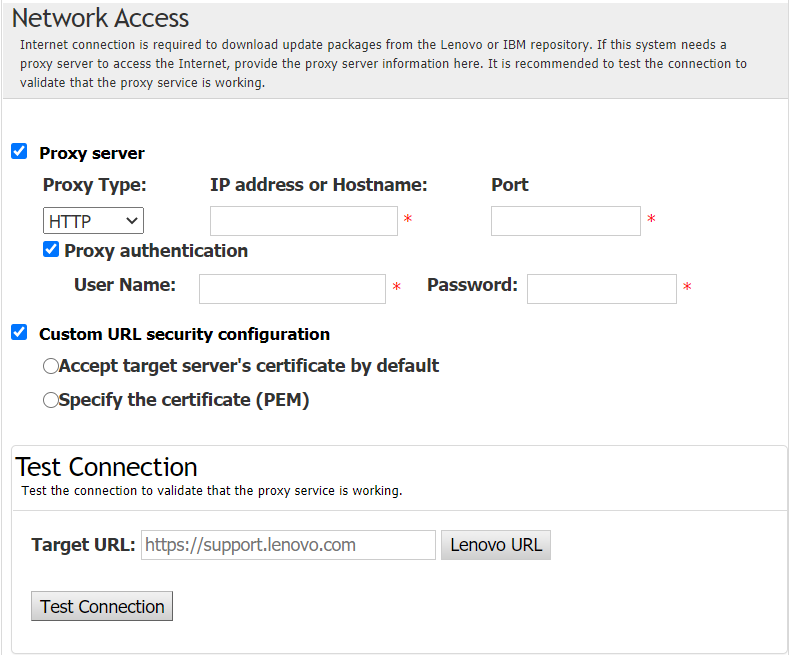Updating multiple remote servers from the Web site
The UpdateXpress application supports to update the remote servers in batch from Web site.
The multi-update function for the remote servers is only supported in the ThinkServer servers and the WenTian server. For details of supported servers, see ThinkServer and WenTian series in Supported server models.
To update multiple remote servers from the Web site, do the following:
- Launch the UpdateXpress application. See Launching the UpdateXpress application.
- In the Welcome window, click Next.
- In the Target Server window, select Multi-server Management, and click Next.
- In the Multi-server Management window, do one or more of the following:
- To add new servers into server pool, select + Add new servers. In the Add new servers window, do one of the following:
Select IP range, input the IP address range and click Discover.
Select Discover by SSDP, select the target adapter and click Discover.
To remove the server from the Server Pool list, select one or more target servers, and click Action > Remove Selected.
To verify whether the user name and password are correct for the server, select one or more target servers, and click Action > Scan Selected.
To export the Server Pool list, select one or more target servers, click Action > Export.
NoteBy default, the Server Pool list will be saved in the JSON file. Users can also select the CSV and XLS format.To import the Server Pool list to other server, select one or more target servers from the list, click Action > Import and select the target JSON file.
- To change the password of the server, select one or more target servers, click Action > Change IP and Password. On the Change IP and Password page, do one of the following:
To change the password for single server, input the new user name and password, and click Execute. The new user name and password will be automatically added to the drop-down list.
To change the password for multiple servers, click Export, modify the password in the exported CSV file, and save the file. Go back to the Change IP and Password page, click Import to add the CSV file, and click Execute.
To view the details of each server, click
 of the target server.
of the target server.
NoteThe user role ofUSERID is Administrator, which cannot be changed. To use common BMC credentials for management, select Input the common BMC credentials -, input user name and password.
- Go back to the Multi-server Management window, click Next, a message will be prompted to remind users to confirm whether the certificate should be updated. Click Accept to update the certificate.Change passwordIf users log in for the first time or the password is expired, change the password in the
window. - In the Task window, select Perform updating on target server and click Next.
- In the Update Setting window, select one or more of the options. If Use a separate remote server instead of the BMC one is selected, input the following information:
(HTTPS/FTP Setting) IP address or Host name: IP address or host name of the server.
(HTTPS/FTP Setting) User Name: User name of the server.
(HTTPS/FTP Setting) Password: Password of the server.
(HTTPS/FTP Setting) Port: Port number of the server. If users do not input, the default port is used.
- (HTTPS/FTP Setting) Directory: The location on the server where update packages are copied to.NoteInput a full path on the HTTPS/FTP server. The FTP server is only used for the ThinkServer marked with superscript 2 (Note 2) in
Supported server models.
- To configure the HTTPS server key fingerprint, do one of the following:
To check the HTTPS server key fingerprint, click Yes.
Not to check the HTTPS server key fingerprint, select Skip check HTTPS server's key fingerprint, and click Next.
- In the Updates Location window, select Check the Lenovo Support Web site, and click Next.
- In the Target Directory window, specify the location for the updates to be downloaded or accept the default location, and click Next.
- On the Internet Access page, if users have no special requirement for security access, click Test Connection to check the network connection of the Target URL, and click Next. If users have more security concerns, before clicking Test Connection, configure Proxy server and/or Custom URL security configuration depending on the security requirements as follows:
Proxy server
Select Proxy Server if users require an HTTP/HTTPS proxy to connect to the Web, and complete the following fields:
Proxy Type The proxy type of the proxy server. IP address or Hostname The host name, IP address, or domain name of the proxy server. Port The port number of the proxy server. Select Proxy authentication if credentials must be specified to authenticate to the proxy server, and complete the following fields:
User Name The user name for authenticating to the proxy server. Password The password for the specified user name.
Custom URL security configuration
Select Custom URL security configuration if users require a reverse proxy, and select one of the following options:Accept target server’s certificate by default
Specify the certificate (PEM)

- In the Update Type window, select the target update type, and click Next.
- In the Update Recommendation window, click Begin to compare the version of firmware with the latest version. After the progress is completed, select one or more target packages, and click Next.NoteTo display all update packages, select
Show updates with no adapters detected before clicking Begin. - In the Acquire Updates window, the acquisition table displays the acquiring progress of the packages. When the progress is completed, click Next.
- In the Update Execution window, click Begin Update and confirm to continue on the pop window. The execution table displays the upgrade progress of the packages. When the upgrade progress is completed, click Next.
- In the Finish window, click the log to check the updates, and click Close to exit.